The ELSI Model in action: A conversation with Mary Voytek

Nathaniel Virgo and Eric Smith at a chalkboard in the ELSI lounge. The formulas involve the fluctuation behavior of small systems, such as chemical reaction networks or evolving populations. (Nerissa Escanlar)
“ELSI’s philosophy is that life emerges as a collaboration among geological processes in an open-system context that is intimately connected by fluxes of energy and matter in the natural environment.
Instead of separating geology and biology and emphasizing their difference, we instead seek understanding through their unification and placement within a common context.
A theory of the origins of life is not a reconstruction of an event or a series of events. Rather, its main subjects must be processes.”
As made clear in this summation – provided by those who formalized the framework of the ELSI Model of the origins of life – their approach was to bring together philosophy and science, or perhaps philosophy based on science. Since the evidence that could elucidate how life began is long since gone, the goal of ELSI origins of life scientists is to better understand the contexts, the processes, and the underlying logic of how life may have begun.
To do that requires endless experimentation, modelling, exploration, theorizing, brainstorming, synthesizing and more. And with this requirement in mind, ELSI Executive Director Mary Voytek explained in our conversation how the model also serves as a roadmap for deciding where the institute should focus its attention:
MK: Can you get more specific about the expansion-gateway pathway and how it has played out in the real world?
MV: You start with gross gateways like: is it possible for a planet other than Earth to be habitable?
You explore the possibilities, and some planets clearly are habitable. This doesn’t come from first principles, but because we have something in front of us where we have analog environments on Earth where we do find life. This involves going back to understanding what in the formational processes of the planets led to the conditions that made Earth habitable in the first place.
You will have a distribution of planets that meet these criteria – planets large enough to hold on to their atmospheres, planets at an optimal distance from their suns, maybe planets that have plate tectonics to keep refreshing the surface with nutrients. We know Mars was habitable because it did have water once, because the chemistry at the surface is consistent with habitability, and there is evidence of all the necessary elements that make up biological systems.
But as you delve in further, many planets will drop out and not progress to the next step. We have a good example in our solar system. We have Venus and Earth, and by prediction both should be habitable. Maybe Mars, too. But in the next winnowing down, Mars lost most of its atmosphere early, and Venus got an uber dose of atmosphere and heated up due to runaway greenhouse. So the expansion of possibilities meets the narrowing at gateways.
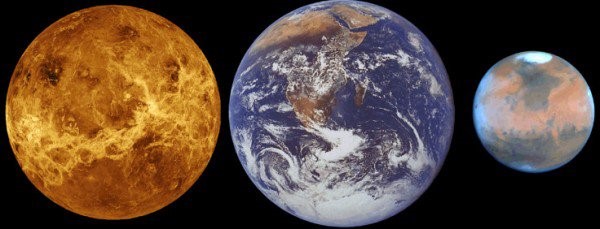
Images of Venus, Earth, and Mars. (European Space Agency)
MK: And I imagine similar processes go on in other arenas.
MV: Yes, there’s the same kind of process present in chemistry.
In the beginning there was “messy” chemistry with a lot of stuff happening under dynamic conditions resulting in imperfect analog molecules that bear the slimmest chemical resemblance to current functional molecules like, for example, RNA. In the same way RNA provides structure and functionality, there’s going to be molecules that are based either on polyester backbones or some other scaffolding molecule, and these molecules can provide functionality – as in catalysis – but less efficiently than RNA. And you might even have a mechanism for how they could reproduce.
That might have been good in the beginning. But these molecules will evolve in structure, acquire the stability with some flexibility necessary to achieve the elegant and efficient biochemistries we see today. It’s like with early enzymes, which were non-specific and bi-directional, and so you could catalyze many reactions and you could destroy as much as you create with them.
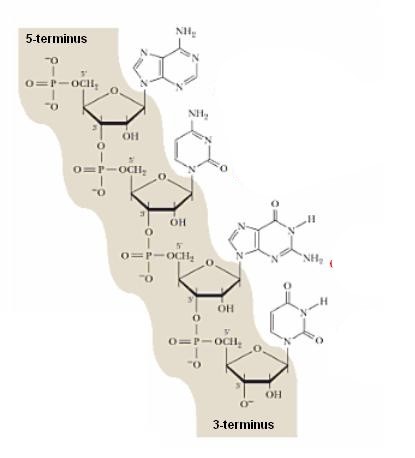
The backbone of RNA consists of the alternating sugar and phosphate groups that make up an RNA molecule. (Wikipedia)
New chemical molecules appear as you diversify, and then they go through a new gateway and that takes you to the next step. A whole swath may make it through and evolve functionality, until at some point you get into sloppy biology which imposes its own selection. So as the chemistry and biology move forward, certain solutions will fall by the wayside to get us ultimately to LUCA.
Here’s an example from early, sloppy biology. You start with cells that are leaky. That can be good for life because you need materials to move in and out of the cell. But it’s not a very good system if you’re trying to concentrate something needed inside the cell, and the cell is working against a diffusion gradient that doesn’t favor it. For example, if you have a lot of salt on one side of a membrane and no salt on the other, lots of salt will move to the no-salt side. But if you need to remove salt or build up salt in excess, you need something active in the membrane – an innovation – to do this.
Most cells need to have the in-and-out leakiness to be directionally controlled. Organisms that live in a salty environment would continue to take up salt that could shut down whatever they’re doing, so they needed to exclude or pump the salts out. By contrast, some organisms need nutrient-bearing salts at higher concentrations within their cell, for example, nitrates – a nitrogen compound known to be important for metabolism. Higher salt concentrations compared to the external environment are needed so there’s enough nitrate for the enzymes to work on.
So how does that happen? There are active receptors and transporters on the membrane that do the work, and so life is getting refined. You’re going from sloppy – where things just go in and out, and where the activity of life isn’t efficient – to getting increasingly more sophisticated, with efficiency as a result of complexity added to the simple biology you started with.
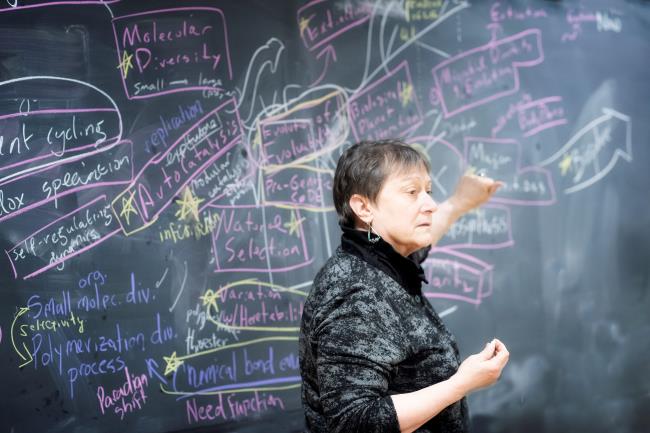
ELSI Executive Director Mary Voytek. (Nerissa Escanlar)
MK: What do you see as the value of the ELSI model for the workings of the institute itself?
MV: We use it to keep our eye on the prize, which is understanding the origin of Earth and the origins of life in a planetary context.
People going down this route need to know when they’re getting off track and their work is tangential. That’s fine to do, but they need to actually always circle back and have an operating plan aimed at trying to answer those questions.
In addition, I think in putting the model together, you start to see who you need to help you out. Planetary modelers need to talk with geologists, and geologists need to talk with biologists and chemists. The result should be highlighting what kind of collaborators you need for your projects, and what kind of science fusions you need to address questions related to that diagram.
MK: ELSI researchers are doing so many things – in fields from galaxy and planet formation, to planetary characteristics, to prebiotic chemistry, electrochemistry, and how all that evolved into biology. Why is the scope so broad?
MV: We are doing many things, and the ELSI model diagram an effort to explain that. It has sometimes appeared to scientists outside ELSI that what we do is random. If we did a series of Miller-Urey experiments they would get it, even though it would have a smaller impact in the world of origins research. So they haven’t been happy with us not having the “ELSI scenario.” But I think this model resonated with them and helped them make sense of ELSI.
We could have focused on a much smaller set of questions about origins, but ultimately we would have had to go back anyway. For example, we know that we needed a reducing environment to have certain reactions occur that were essential at the very beginning. Models of how Earth formed originally suggested it wasn’t a reducing environment.
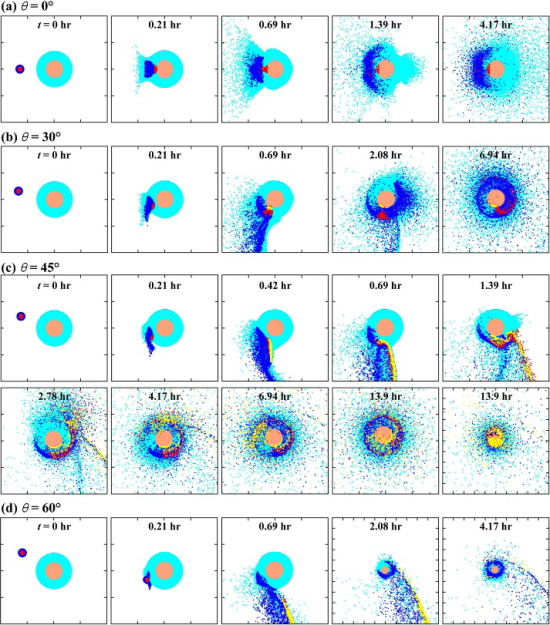
Models of an impactor hitting a planet. (Genda, Brasser, and Mojzsis/ Earth and Planetary Sciences Letters. 2017)
But (ELSI planetary scientist Ramon Brasser), (ELSI planetary scientist Hidenori Genda), and (University of Colorado, Boulder geologist Stephen J. Mojzsis) have worked out a single large impactor model as part of Earth’s formation. That actually demonstrates we probably did have a more reducing environment than an oxidizing one.
This was confirmed by some of the information from the rock record that (ELSI biogeochemist Yuichiro Ueno) works on. From the early Earth samples he has studied, he also predicts the atmosphere had more carbon monoxide than carbon dioxide, and so it was more reducing. And then some of the cosmochemistry that others have done on different bodies similarly supports that conclusion.
These planetary and Earth scientists – knowing what would be conducive to support reactions that we think must have happened – have managed to find three separate lines of evidence about what’s possible in a system. And from there they can predict what was then likely. It goes from what we need, what we need to get to, what we know is possible, and then to “this must have been the scenario that happened.”
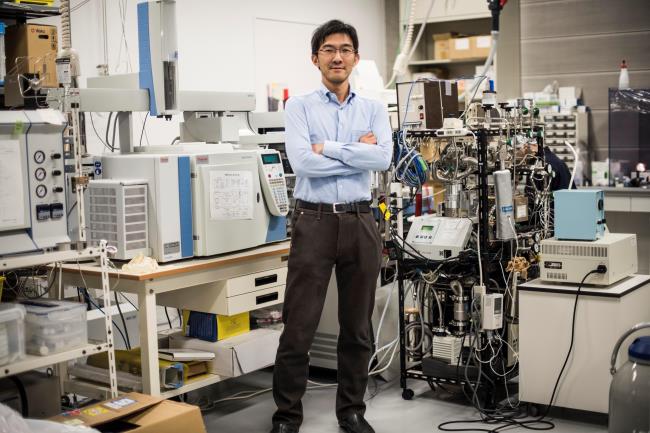
Yuichiro Ueno in his ELSI lab. (Nerissa Escanlar)
MK: What do you plan to emphasize in the years ahead?
MV: One significant focus should be the possibilities of life beyond our own solar system – exoplanets -- and how life elsewhere might help in the understanding of how life began here. Another is how, after a planet forms, it operates to create environments that allow for pre-biotic chemistry and to evolve a system that could sustain life on that planet.
We would continue to work on and expand our understanding of messy chemistry – adding in a consideration of the diversity and evolution of Earth’s environments and using theoretical methods to incorporate scales of time and space not accounted for in laboratory experiments. Then there’s a universal biology section, looking at fundamental principles of natural law that might be able to explain the expansion from LUCA into the modern biosphere. This would involve higher level evolutionary processes, maybe even beyond that to the evolution of cognition.

The ELSI building on the Tokyo Institute of Technology campus. (Nerissa Escanlar)
Definitely, we want to understand much better the features that got fixed in LUCA – like the alphabet (of amino acids) for proteins, and the ultimate functionality of systems and why that might have evolved that way.
This includes the presence and role of intermediates (molecules that are precursors of biologically more significant molecules). If you look at a circuit diagram of all the metabolisms that go on in the cell, you’ll see there are certain places where intermediates are used by a bazillion reactions. That makes sense. Instead of “I need this and here’s how I make it,” or “I need that and here’s a brand new intermediate,” it’s more like having the eggs, the butter, the flour, the sugar, and you can make lots of things. You don’t start out with an important intermediate molecule useful in only one situation.
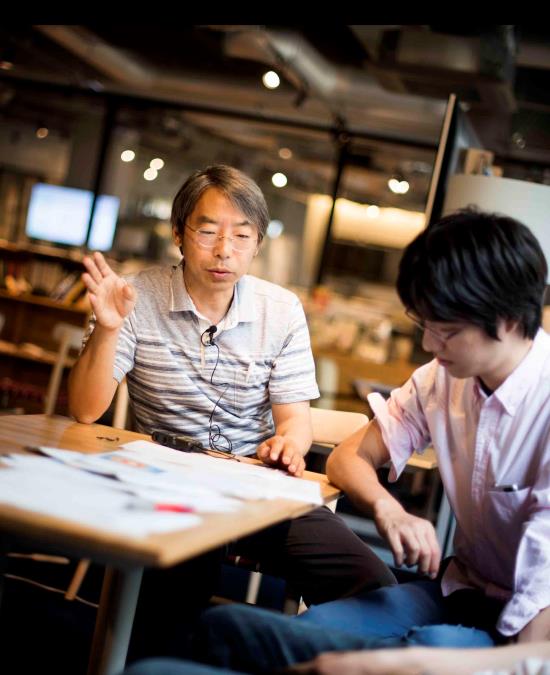
ELSI Director Kei Hirose with his student. (Nerissa Escanlar)
MK: Do you have some final thoughts you would like to share?
MV: For me, this is a rallying diagram. This leaves nobody off and everyone will find their place on this diagram. (An ELSI scientist) came in to talk, and asked if he needed to change his field and become a biochemist in order to contribute. I said, please don’t. But I said we do need you to be thinking about the downstream processes (model), so you see what’s important to us and how all of our work fits together. Why, for instance, we need to use your knowledge of the redox condition of the early Earth – because there are some essential reactions that are dependent on that.
This is important to capture: everyone has something to contribute and we value it all.
For the broader outside world, this ELSI model may not be brand new. But nobody has adopted it as a philosophy for why we do the research. Because we have a whole institute that’s focused on this, we can work toward figuring out the connections in a unique way.
------
Marc Kaufman has written books on astrobiology and Mars, has been a longtime reporter at The Washington Post and The Philadelphia Inquirer, and writes the NASA-supported online column Many Worlds (www.manyworlds.space) He has also had the good fortune to visit and work at ELSI numerous times and he wrote "ELSI RISING" -- the story of ELSI's origins and evolution -- in 2017.
